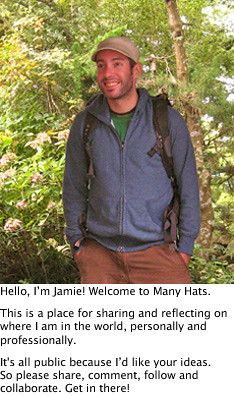Making Time for Doing It
Nearly every school year, somewhere early on, I end up doing some sort of informal survey, or engaging in a broad conversation with my students about different ways of learning. The learning strategies I touch on mostly draw from Howard Gardner’s Multiple Intelligences.
This year, just ankle-deep in our first unit of inquiry (an exploration of ways in which our own and other cultures enrich our lives) we became involved in an inquiry into ways of collecting results when posing questions to groups.

Students present their collaboratively-developed data collection tool for peer critique and re-design considerations. (Photo by Jamie Raskin)
Students flexed their prior knowledge by independently developing tools for collecting data. We shared and critiqued some of these tools, applied our new insights to the design of new data collection tools in small teams, then presented them, tested them, critiqued them and came up with a list of essential elements of a quality data collection tool. Students then individually applied their understanding of these essential elements to build their own super-tool for posing questions and collecting answers. I’ll go into more detail on that unit-integrated math inquiry in another post.
I mention it because the question I posed and developed a data-collection tool for was How do you think you learn best? I gave students the options of answering: by reading, by seeing, by listening, by doing or by another way. Not surprisingly, my students answers were about 75% by doing. This result is absolutely in keeping with the answers I receive every time I ask a class this question. It’s also the way I would personally answer it.
Certainly, one reason I ask the question is to collect and consider the learning preferences of my class, and another is to provoke their metacognition and self-awareness of learning styles. It also gives me some reference points for planning teacher-guided learning experiences and some common vocabulary for discussing their strategies for student-led inquiry.
By coincidence the video LEARN came back across my inbox this morning. It’s part of a trilogy of shorts created by a few guys who traveled the world a couple of years ago and composed these short global video reflections MOVE, EAT and LEARN. What I noted, re-watching it, was how nearly every learning experience the filmmakers share from their odyssey is one that is hands-on. Them and others constructing learning by doing.
LEARN from Rick Mereki on Vimeo.
Clearly, this overwhelming preference for learning by doing is not unique to the groups that have populated my classrooms. It is, I would suggest, global.
In my last post, I focused on different inspirations for designing time in a classroom. These decisions are, I feel, among the most important that a teacher makes. I promised that in my next post (which is now this one), I would begin to itemize my beliefs on the essential ingredients of a school day. Well here is something which must clearly be number one. A priority in my daily schedule has to be ample time for students to learn by doing. Hands-on, minds-on, hearts-on and senses-on doing.
In my next post, I’ll continue to grow this checklist of daily priorities.
The Essential Ingredients of a Quality Day of Learning:
- Ample time for hands-on, minds-on, hearts-on and senses-on doing.
Related
2 Responses to Making Time for Doing It
Leave a Reply Cancel reply
This site uses Akismet to reduce spam. Learn how your comment data is processed.
MY CLASS BLOG
This is my classy, yet personal blog. For my less personal –but perhaps classier– classroom blogs, click here, or here.MANY HATS in your inbox
Subscribe to Many Hats...

many hats by Jamie Raskin is licensed under a Creative Commons Attribution-NonCommercial-ShareAlike 3.0 Unported License.Details… details…
CATEGORIES
@jamieraskin
My TweetsINVASION PROGRESS
HISTORY
MANY COMMENTS








[…] Making Time for Doing It […]
[…] explored my sense of what should be part of each school day I’ve looked at the value of hands-on, hearts-on learning, and of being outdoors, physical and creative. This time I want to look a little bit more at the […]